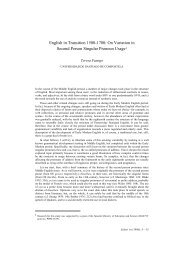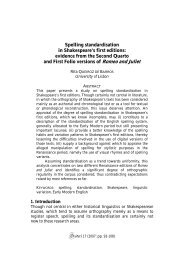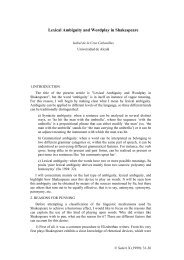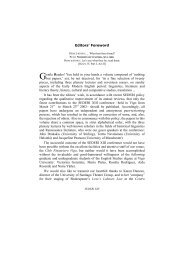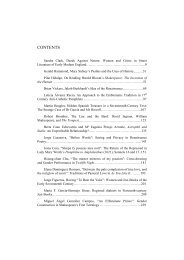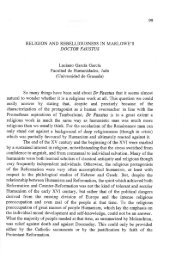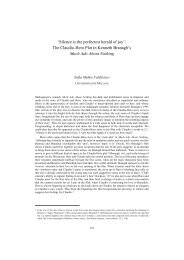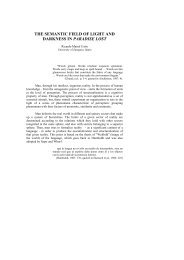GENDER, DISGUISE AND THE POLITICS OF MARRIAGE ... - SEDERI
GENDER, DISGUISE AND THE POLITICS OF MARRIAGE ... - SEDERI
GENDER, DISGUISE AND THE POLITICS OF MARRIAGE ... - SEDERI
Create successful ePaper yourself
Turn your PDF publications into a flip-book with our unique Google optimized e-Paper software.
Gender, Disguise a n d t h e Politics o f Ma r r i a g e in<br />
Ar i a d n e’s Sh e Ve n t u r e s a n d He Wi n s<br />
Au x i l i a d o r a Pérez Vi d e s<br />
University of Huelva<br />
In spite of being considered as a minor dramatist, with She Ventures and He Wins (1695)<br />
Ariadne reopened the tradition of female playwrights after Aphra Behn’s death. In the<br />
main plot of the play, Charlotte, a young and rich heiress, makes a deliberate use of<br />
crossdressing and disguise in order to test the man she herself has chosen to marry.<br />
Through the acquisition of a new identity, the female protagonist plays a joke both<br />
on the patriarchal power over women as regards the choice of a husband and also<br />
on the conventional terms of marriage, like money and social class, usually settled by<br />
male figures. Therefore, the aim of this paper is to trace the features of the active and<br />
manipulative heroine that Behn had already established in plays such as The Rover (1677)<br />
and to check the way in which Ariadne complies with those principles.<br />
The notion of an original or primary gender identity is often parodied within the<br />
cultural practices of drag, cross-dressing, and the sexual stylization of butch/ femme<br />
identities... In imitating gender, drag implicitly reveals the imitative structure of gender<br />
itself -as well as its contingency. (Judith Butler)<br />
The control of the patriarchal system over women’s identity pervaded many<br />
of the plays of the English Restoration period. Very frequently, playwrights<br />
portrayed the different ways in which men exercised their authority and restrained<br />
women from behaving beyond the codes of obedience and submission. Within<br />
the family, the unavoidable rule of the male heads of households –either fathers<br />
or brothers– obliged women to comply with the conditions and circumstances<br />
that superior male figures had set for their future, which meant above all the<br />
attainment of a secure and profitable marriage. Traditionally, men established<br />
their own foundations for the only possible relation between man and woman<br />
and they made plans for marriage contracts that granted wealth and a high social<br />
position to the family, without considering the individual interests of women.<br />
This practice of arranged marriages turned women into merchandise that<br />
could be bought and sold for the sake of a successful deal. As a result of this,<br />
the revision of the politics of marriage from a female perspective became one<br />
of the major concerns of women and women writers of the period:<br />
From about the mid-1680s until 1713 or thereabouts, unprecedented numbers of<br />
271
Au x i l i a d o r a Pérez Vi d e s<br />
women wrote on women’s conditions [...] It was the first sizable wave of British<br />
secular feminist protest in history. Many were inspired by the general philosophical<br />
shift towards a rational and empirical analysis of life that rejected tradition and<br />
encouraged self-confidence and independent thought. (Ferguson 1985: 15)<br />
The appearance of works by authors such as Aphra Behn gave rise to a<br />
widespread criticism of this sexual inequality in which women had been trapped<br />
for long, and very frequently women writers used their works to challenge the<br />
stability of the patriarchal system. The standard codes of female behaviour began<br />
to be strongly rejected and there was a tendency to deconstruct the stereotypes<br />
that enclosed women in the only possible roles of virgins, bound for marriage<br />
or religious life, and prostitutes. Disguise and crossdressing were then two of<br />
the most common strategies used by these authors in order to provide female<br />
characters with the agency and independence that they had been denied. In spite<br />
of being considered as a minor dramatist, Ariadne’s She Ventures and He Wins (1695)<br />
meant not only the recovering of plays by female playwrights to be performed<br />
after Aphra Ben’s death, but also the continuation of the features of the active<br />
and manipulative heroine which Behn had inaugurated in plays like The Rover<br />
(1677) or The Feigned Courtesans (1679).<br />
The play deals with the deeds of a young and rich heiress –Charlotte–, who<br />
rebels against social and familiar expectations and tries to find a man that may<br />
marry her not for money but for love. Far from submitting to male rules, she<br />
decides to take up a fake identity and step into the male realm where virtuous<br />
women were not supposed to enter. That change is performed by means of<br />
crossdressing which, together with the complicity from other female characters,<br />
enables her not only to gain the love of Lovewell, the man she herself has<br />
chosen for her future husband, but also to test his truthfulness and constancy.<br />
Hence, this strategy becomes a tool to defy both the power of patriarchy and<br />
the traditional terms in which marriage is defined.<br />
The analysis of the relation between female use of disguise and the politics of<br />
marriage can be structured in three main sections within the present study. First,<br />
we will trace the meanings and implications that transvestite women represented<br />
at the time in which the action is set, considering issues like its reception and the<br />
subversion of social and sexual roles that it conveyed. Secondly, the proceedings<br />
of the plans of the heroine in Ariadne’s play will be explored, taking into account<br />
the reasons and strategies to develop her project. And finally, the last step will<br />
be the interpretation of the way in which the protagonist manages to break<br />
patriarchal impositions and to succeed in shaping the kind of marriage she wants<br />
for herself, without threatening her virtue.<br />
Although it was a recurrent motif in the plays of the English Restoration,<br />
previous writers had already displayed in their works the experiences of<br />
characters that made use of transvestism in order to achieve their aims. Yet, the<br />
main innovation lies in the performative means in which it was acted on stage,<br />
since with the entrance of actresses on the stage in 1660, female writers could<br />
think of their heroines to be performed by women, in contrast with the theatrical<br />
rules that had left them out so far (Howe 1992: 20). In this sense, the social and<br />
272
Gender, Disguise a n d t h e Politics o f Ma r r i a g e in Ar i a d n e’s Sh e Ve n t u r e s a n d He Wi n s<br />
theatrical circumstances that were incorporated in this period contributed to the<br />
re-articulation of this device from new, feminist perspectives.<br />
Nevertheless, the reception of transvestite women was not systematic among<br />
the seventeenth century audience. As Jacqueline Pearson points out, “men in the<br />
audience do not seem to have found it threatening, though female spectators<br />
may have been offered a ‘sense of release’ by watching women escaping the<br />
constrictions of a conventional female role” (1988: 102). Male spectators used to<br />
perceive this theatrical custom as an erotic stimulation, that involved both the<br />
pleasure of watching the body of real actresses in men’s clothes and also a sort<br />
of ‘homo-erotic fantasy’ that turned this type of performance into an excellent<br />
method to exorcise their hidden homosexual tendencies. The effect contrasts<br />
ironically with the intention of the writers, which was mostly to mock male<br />
behaviour and subvert the traditional notions of gender differentiation that had<br />
always marginalized women to the level of material property. On the contrary,<br />
with female characters that adopt many different identities and conceal their<br />
supposedly “natural” gender, women dramatists question the common belief<br />
that marked these acts as dangerous, and they suggest that not only is gender<br />
not stable but also that its boundaries can be easily transgressed. Both ideas are<br />
indeed present in She Ventures and He Wins, where, like Behn had done before,<br />
Ariadne deals with an active heroine that decides to pretend to be someone<br />
else as a means to redefine the politics of marriage from the point of view of<br />
women. At the beginning of the play Charlotte examines these conventions that<br />
used to be set by men and she tells her cousin:<br />
I’m not obliged to follow the world’s dull maxims, nor will I wait for the formal<br />
address of some ceremonious coxcomb, with more land than brains, who would<br />
bargain for us as he would for his horse [...] No, my Julia, I’ll have one who loves<br />
my person as well as gold and please myself, not the world, in my choice. (I. 1.<br />
35-53)<br />
The heroine creates her own version of a prosperous marriage and throughout<br />
the play she insists in checking that her lover wants her out of true love and<br />
not because of her money. Disguise is then her best vehicle to make sure that<br />
love and marriage take place according to her interests and she undermines the<br />
possible results of her acts upon the established social order.<br />
In her process to test Lovewell’s constancy and truthfulness, Charlotte<br />
makes different uses of crossdressing and disguise, starting with her approach<br />
to the male realm in which she can have closer contact with men. With a male<br />
appearance, the heroine can address her lover directly and even share some<br />
sort of complicity with him:<br />
CHARLOTTE: I have evidences enough confirms me, you’re the man that has<br />
cruelly robbed a near and dear relation of mine of her repose for ever, and except<br />
you restore it her by reciprocal love, I fear the worst effects of this unhappy<br />
passion.<br />
LOVEWELL: Oh sir, I find you design to divert yourself instead of me.<br />
CHARLOTTE: By honour, trust, and all that’s sacred, I’m serious.<br />
LOVEWELL: Well sir, bring me to the lady; I’m so cruelly inclined to let a pretty<br />
273
Au x i l i a d o r a Pérez Vi d e s<br />
woman for any civil kindness I can do her. (I. 3. 45-53)<br />
This is, according to conventional standards of female behaviour, a very<br />
challenging act for a woman, but, by adopting a typically male attire, Charlotte<br />
manages to speak openly to this man and even demand attention and favour<br />
from him. Thus, through this resource women like her can escape from their<br />
confined scope of private, submissive settings since “when women took men’s<br />
clothes, they symbolically left their subordinate positions and enclosed spaces.<br />
They became mobile, masterless women, and this threatened overthrow of<br />
hierarchy was discursively read as the eruption of uncontrolled sexuality”<br />
(Howard 1994: 101).<br />
Charlotte’s skill to progress in her plans is also displayed through the way in<br />
which she continues deceiving Lovewell. Once she has teased him and inflicted<br />
suspense upon him, she makes sure that he turns to her own brother –Sir Charles<br />
Frankford–, asking about her, and after that, she arranges a meeting in which the<br />
mentioned lady will meet him in a mask. At this moment, as an alter ego of the<br />
author that directs and organizes the actions, Charlotte is the very one who is in<br />
control of the situation and she is able to set the conditions for the future relation<br />
between them: “and if you have courage to venture on me as you see me, here’s<br />
a hand and heart, and all that’s mine to be entirely yours” (III. 3. 31-33). Again, the<br />
heroine tries to check if he would marry her whatever her physical and economic<br />
circumstances may be, and she becomes the very director of their future.<br />
These particular performances of crossdressing and disguise in the first three<br />
acts of the play result into their marriage, which they celebrate in a tavern, a space<br />
virtuous women were required to avoid, because of its traditional association<br />
with prostitution. Anyway, ignoring this threat to her female virtue, Charlotte<br />
develops her aspirations further: to puzzle her lover by means of fake identities.<br />
At the tavern, Charlotte suddenly leaves Lovewell with no other company than<br />
a purse with some money, and, following Sir Charles’s directions, he goes to<br />
the village where she has suddenly fled after their wedding in order to give her<br />
a letter. At this stage, Charlotte had decided that her cousin –Bellasira–, would<br />
pass herself off as Charlotte so that, again, she can test whether he loves her<br />
for herself or because she is sister to a prosperous and respectable man. Being<br />
completely deceived by Bellasira, the effect of this strategy favours her projects<br />
again, as Lovewell admits to Bellasira:<br />
Forbear, dear madam, to distract me with this angel’s goodness, I am not worthy<br />
of the least of all this mighty kindness [...] I love with all the ardour of prevailing<br />
passion, a false ungrateful woman, and what renders my folly inexcusable, one I<br />
know not, nor ever perhaps may see again. (IV.4. 33-44)<br />
Thus, Lovewell renounces the high social position and benefits that his<br />
marriage to whom she believes to be Sir Charles’ sister could bring forth, but,<br />
on the contrary, he declares in despair that he is in love with another woman In<br />
spite of his rage, Charlotte still attempts to develop her plans further. This time she<br />
relies on the complicity of her own brother and his friend Roger, who, all along<br />
the play have complied with her actions and decisions, against all expectations<br />
274
Gender, Disguise a n d t h e Politics o f Ma r r i a g e in Ar i a d n e’s Sh e Ve n t u r e s a n d He Wi n s<br />
of the patriarchal authority that they represent. Once they check that Charlotte’s<br />
aims are “honourable”, both of them forsake the part of the patriarchal power<br />
of the missing father to help her in her aims: “to find which he has most esteem<br />
for, my person or state” (V.1.6-7). They imprison Lovewell for keeping the money<br />
from that purse in the tavern and, it is in the prison where, sent by Charlotte,<br />
Bellasira tries to tempt him again:<br />
BELLASIRA: Is it so hard to love? I have youth and fortune, is that no charm?<br />
LOVEWELL: ...I must tell you, to justify myself from that ingratitude, you justly<br />
might reproach me with: I am to my destruction married, married, dear lady.<br />
(V.1. 148-150)<br />
Hence, after all her efforts to create a different notion of marriage and the<br />
relation between its members, Charlotte succeeds in her attempts. On the one<br />
hand, the very last consequences of her cunning strategies demonstrate that they<br />
have been effectively developed, for Lovewell is completely amazed when he<br />
sees the Charlotte he was in love with approaching him when he was still in jail.<br />
Even in the last scene of the play, she keeps him under her control telling him<br />
that Roger, her brother’s friend, had loved and proposed to her long ago. But,<br />
however cruel she is to him, and when all misrecognitions are solved, Lovewell<br />
replies: “Well, I will live with thee, for heaven knows I love thee; and though you<br />
have used me thus, will always use you well” (V. 1. 245-247). Like all throughout<br />
the play, he admits his constant love for her and that confirms the importance<br />
of all her resources for the attainment of her happiness.<br />
On the other hand, regarding social order, these particular cases of<br />
crossdressing and disguise prove that although women can break traditional<br />
gender distinctions, they can still keep their honour unspoiled. In the play,<br />
Charlotte tricks and deceives her lover repeatedly as part of her teasing game,<br />
but when Sir Charles reveals that she is his sister –the very same woman that<br />
Lovewell loves and a rich heiress with a state–, he answers: “dear madam, from<br />
the sincerity I ever used to you, ‘tis the least part of my joy; but I have, by my<br />
knowledge who you are, an unquestioned proof of your virtue” (V. 1. 270-<br />
273). Somehow, Charlotte never did lie to him but just used him for honourable<br />
interests like love and marriage and, in spite of using women’s bodies as her<br />
main tools, she could never be accused of looseness or prostitution, with which<br />
crossdressing was strongly associated.<br />
That gender differentiation was a widespread concern in Early Modern<br />
England can be inferred from works like Hic Mulier, the anonymous Renaissance<br />
tract in which this differentiation is assigned to God, who dictated that man’s<br />
clothes were “fit for his labour, the woman’s fir for her modestie” (Keeble 1994:<br />
245-246). According to this, gender categories could not be violated since any<br />
change of identity could generate a break in the patriarchal hierarchy that placed<br />
men in a superior position. However, in She Ventures and He Wins, Ariadne follows<br />
the trend of other female playwrights who rejected that separation of gender by<br />
means of using active heroines that decide to take up an unnatural appearance.<br />
These women challenge the permanence of that system and, as Judith Butler<br />
275
Au x i l i a d o r a Pérez Vi d e s<br />
infers, their acts show how “genders can be neither true nor false, neither real<br />
nor apparent, neither original or derived. As credible bearers of those attributes,<br />
however, genders can also be rendered thoroughly and radically incredible” (1990:<br />
141). Charlotte then, turns out to be a symbol for Ariadne’s defence of women’s<br />
right to play with their bodies, as she tries to prove that it is legitimate to validate<br />
the use of transvestism and disguise as a means of achieving a sort of marriage<br />
in which women may take an active and independent part.<br />
REFERENCES<br />
Ariadne 1991: She Ventures and He Wins. >Lyons and Morgan eds. 103-59.<br />
Butler, J. 1990: Gender Trouble: Feminism and the Subversion of Identity. London, Routledge.<br />
Ferguson, M. ed. 1985: First Feminists: British Women Writers 1578-1799. Bloomington, Indiana<br />
UP.<br />
Howard, J. E. 1994: The Stage and Social Struggle in Early Modern England. London, Routledge.<br />
Howe, E. 1992: The First English Actresses: Women and Drama 1660-1700. Cambridge, Cambridge<br />
UP.<br />
Keeble, N. H. ed. 1994: The Cultural Identity of Seventeenth-Century Woman: A Reader. London,<br />
Routledge.<br />
Lyons, P. and F. Morgan eds. 1991: Female Playwrights of the Restoration. Five Comedies. London,<br />
Everyman.<br />
Pearson, J. 1988: The Prostituted Muse: Images of Women and Women Dramatists. 1642-1737. New<br />
York, St. Martin’s Press.<br />
276



